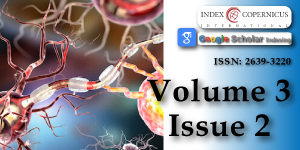Comparative study of carboxylate and amide forms of HLDF-6 peptide: Neuroprotective and nootropic effects in animal models of ischemic stroke
Main Article Content
Abstract
Aim:The work was to perform a comparative study of the neuroprotective and nootropic activities of two pharmaceutical substances, the HLDF-6 peptide and its amide form (HLDF-6-NH2).
Materials and Methods: We used in the study healthy adult male Wistar rats aged 180–200 days weighing 280–300 g. We modelled ischemic stroke in rats by chronical occlusion of carotid arteries. Solutions of the HLDF-6-NH2 and HLDF-6 peptides were administered intranasally. Cognitive functions we assessed with Novel object recognition test and Morris maze.
Results: The amide form of HLDF-6 peptide is more efficient: the neuroprotective activity of HLDF-6-NH2, evaluated by improvement of cognitive functions in animals, surpassed that of the native HLDF-6 peptide. A dose of 250 µg/kg of HLDF-6-NH2 peptide resulted in practically complete restoration of the disturbed functions. In the model of ischemic stroke, the amide form of the peptide significantly excelled the reference substance mexidol both in the effective dose and biological activity.
Conclusion: The results of study of the agent allow hoping for its success in further clinical investigation. In view of high demand for the agent and in case of successful clinical trials, it will surely become widely used in clinical practice in treatment of IS.
Article Details
Copyright (c) 2019 Bogachuk AP, et al.

This work is licensed under a Creative Commons Attribution 4.0 International License.
Feigin VL, Forouzanfar MH, Krishnamurthi R, Mensah GA, Connor M, et al. Global and regional burden of stroke during 1990–2010: findings from the Global Burden of Disease Study. Lancet. 2010; 383: 245-255. PubMed: https://www.ncbi.nlm.nih.gov/pubmed/24449944
Rybnikov VYu, Zakutsky NG. Peptide regulation of the brain functions. Stela. Sankt-Petersburg. Russia. 2000.
Koroleva SV, Ashmarin IP. Development and application of an expert system for analysis of the functional continuum of regulatory peptides. Russ J Bioorg Chem. 2006; 32: 224-230. PubMed: https://www.ncbi.nlm.nih.gov/pubmed/16808167
Kostanyan IA, Astapova MV, Starovoytova EV, Dranitsyna SM, Lipkin VM. A new human leukemia cell 8.2 kDa differentiation factor: Isolation and primary structure determination. FEBS Lett. 1994; 356: 327-329. PubMed: https://www.ncbi.nlm.nih.gov/pubmed/7805865
Kostanyan IA, Astapova MV, Navolotskaya EV, Lepikhova TN, Dranitsyna SM, et al. A biologically active fragment of the differentiation factor of the HL-60 line cells: Identification and properties. Russ J Bioorg Chem. 2000; 26: 450-456. PubMed: https://www.ncbi.nlm.nih.gov/pubmed/11008640
Sakharova N Yu, Kostanyan IA, Lepikhova TN, Lephihov KA, Navolotskaya EV, et al. Effects of synthetic peptides TQVEHR and NGENHR on early mouse embryo development in vitro. Doklady Biochemistry. 2000; 372: 84-86. PubMed: https://www.ncbi.nlm.nih.gov/pubmed/10935171
Rzhevsky DI, Zhokhov SS, Babichenko II, Goleva AV, Goncharenko EN.et al. HLDF-6 peptide affects behavioral reactions and organism functions dependent on androgen hormones in normal and castrated male mice. Regulatory Peptides. 2005; 127: 111-121. PubMed: https://www.ncbi.nlm.nih.gov/pubmed/15680477
Kostanyan IA, Zhokhov SS, Storozheva ZI, Proshin AT, Surina EA, et al. Neuroprotective effect of the hexapeptide HLDF-6 on rat hippocampal neurons on the in vivo and in vitro models of Alzheimer`s disease. Russ J Bioorg Chem. 2006; 32: 360-367.
Sewell RD, Gruden MA, Pache DM, Storozheva ZI, Kostanyan IA, et al. Does the human leukaemia differentiation factor fragment HLDF6 improve memory via brain DNA and protein synthesis? J. Psychopharmacol. 2005; 19: 602-608. PubMed: https://www.ncbi.nlm.nih.gov/pubmed/16272181
Storozheva ZI, Proshin AT, Zhokhov SS, Sherstnev VV, Rodionov IL, et al. Hexapeptides HLDF-6 and PEDF-6 restore memory in rats after chronic intracerebroventricular treatment with beta-amyloid peptide a beta (25-35). B Exp Biol Med. 2006; 141: 319-322. PubMed: https://www.ncbi.nlm.nih.gov/pubmed/17073149
Kostanyan IA, Storozheva ZI, Semenova NA, Lipkin VM. Postischemic administration of HLDF-6 peptide ameliorates cognitive dysfunction and brain damage induced by chronic cerebral Ischemia in rats. Doklady Biological Sciences. 2009; 428: 418-422. PubMed: https://www.ncbi.nlm.nih.gov/pubmed/19994779
Bogachouk AP, Storozheva ZI, Solovjeva OA, Sherstnev VV, Zolotarev Yu A, et al. Comparative study of the neuroprotective and nootropic activities of the carboxylate and amide forms of the HLDF-6 peptide in animal models of Alzheimer’s disease. J Psychopharmacol. 2016; 30: 978-921. PubMed: https://www.ncbi.nlm.nih.gov/pubmed/26628555
Mironov AN, Bunyatyan ND, Vasiljeva AN, Verstakova OL, Zhuravleva MV,et al. Manual for preclinical trials of medicinal agents. Part 1. Moscow: Grif and Co. 2012.
Choi BR, Kwon KJ, Park SH, Jeon WK, Han SH, et al. Alternations of Septal-hippocampal System in the Adult Wistar Rat with Spatial Memory Impairments Induced by Chronic Cerebral Hypoperfusion. Exp Neurobiol. 2011; 20: 92-99. PubMed: https://www.ncbi.nlm.nih.gov/pubmed/22110366
Cechetti F, Pagnussat AS, Worm PV, Elsner VR, Ben Jda Costa, et al. Chronic brain hypoperfusion causes early glial activation and neuronal death and subsequent long-term memory impairment. Brain Res. Bull. 2012; 87: 109-116. PubMed: https://www.ncbi.nlm.nih.gov/pubmed/22040859
Zhokhov SS, Kostanyan IA, Gibanova NV, Surina EA, Rodionov IL, et al. Different mechanisms of protective and differentiative activities of homological peptides TGENHR and TQVEHR. Biochemistry-Moscow. 2004; 69: 861-869. PubMed: https://www.ncbi.nlm.nih.gov/pubmed/15377265
Rzhevskiy DI, Kravchenko IN, Sadovnikova ES, Rasskazova EA, Novikova NI, et al. Preclinical trials of safety of the nootropic remedy on the base of amide form of the fragment of leukocytes differetntiation factor. Biopharmaceutical Journal. 2017; 9: 50-56.





